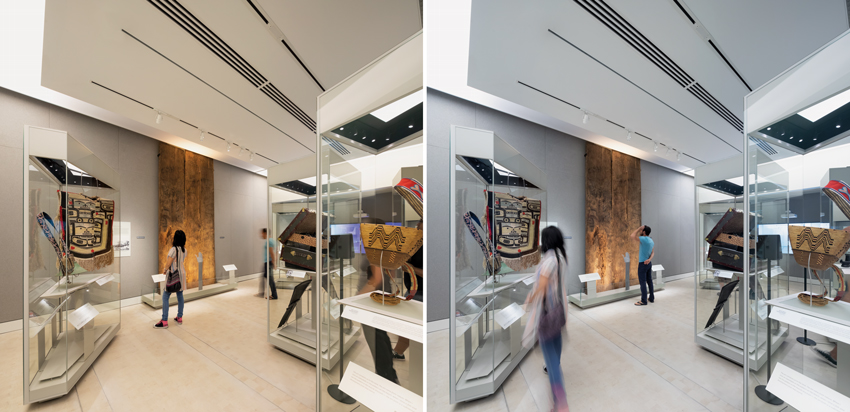Daylight and Electric Illumination
The light shelf’s configuration, dimensions, and placement were arrived at after rigorous examination not typical for a tenant fit-out project, according to MacDougall. This analysis included parametric modeling, taking into account such factors as: the light transmittance of the glazing; the height and location of work surfaces, material finishes, and colors; and the surrounding buildings that block access to sunlight. In addition, the team erected a full-scale mock-up, in a single bay of the 18th floor, to physically test its capabilities, but also to demonstrate to the Wilshire’s owner that, from the exterior, Arup’s offices would be indistinguishable from those of other tenants.
The firm, which moved into the space in the middle of April, expects that at least 83.75 percent of open office workstations will receive enough daylight (30 foot candles) to make electric illumination unnecessary for at least half of the annual occupied hours. The innovative aspect of the scheme, according to MacDougall, is that it fuses daylight with electric lighting. For those times when the sun is not adequate, a linear LED lamp, incorporated into the top of the light shelf, along with a pendant LED luminaire suspended over a circulation zone, near the core, will be in use.
Both electric-illumination sources are indirect, relying on the ceiling to reflect light and enhance the perceived brightness, explains MacDougall. Both sources are also tunable, adjusting, like the LEDs at Delos, via time-clock controls and photo sensors, to qualitatively align with the spectral distribution and intensity of the daylight bouncing off the light shelf.


PHOTOGRAPHY: © EMA PETER
A new gallery at the Museum of Anthropology at the University of British Columbia in Vancouver (all above) relies on tunable-white LEDs to mimic actual daylight conditions in real time. A rooftop sensor reads outdoor lighting color and intensity, and a control system adjusts the room’s illumination accordingly.
Tunable systems are occasionally used as a proxy for daylight in spaces without access to sunlight. This is not always for occupant health or productivity reasons, but instead to enhance experiential qualities. Such was the case with the creation of a 1,600-square-foot gallery for First Nations’ artifacts at the Museum of Anthropology at the University of British Columbia in Vancouver. The room, a former theater in an early-1970s Arthur Erickson building, had only one small, north-facing window. Although the situation was desirable from a conservation standpoint—many of the objects are fragile and vulnerable to UV degradation—it was less than ideal for museum visitors, since most of the treasures, which include carvings, textiles, and basketry, are best appreciated under daylight.
Stantec, along with AES Engineering for the lighting and electrical design, created a “skylit” room that mimics the actual daylight outside. A shallow, 4-foot-wide cove was built at the perimeter, concealed by stretched PVC. Above the translucent surface are tunable-white LEDs, hung from the existing slab at an angle. The configuration—arrived at both through simulation and physical mock-ups—helped maximize the distance between PVC and the lamp, and allowed the backlit surface to glow uniformly without the individual lamps’ being discernible, explains Doug McMillan, a lighting designer at AES. The center of the ceiling includes some track lighting, while the display vitrines incorporate organic light-emitting diodes (OLEDs), well suited to confined spaces. But most of the gallery’s lighting is provided by the luminous cove and its LEDs, connected to a DMX controller (a digital communication network first created for theatrical lighting) and a roof-mounted sensor that reads correlated color temperature and illumination levels. Since there was no off-the-shelf sensor available that measured both attributes and met other project requirements, the team made its own device with parts that included a camera sensor. The apparatus takes a reading every three minutes, gradually shifting from cool to warm to cool over the course of the day and registering changing weather conditions, diminishing the brightness in the gallery when it is cloudy. The installation is so successful claims McMillan, that museum-goers sometimes visit the space multiple times in a single day to view an object under different light.
Although Mcmillan’s gallery-lighting scheme seeks to emulate daylight rather than augment it, the Vancouver project, like the offices of Delos in New York and Arup in Los Angeles, illustrates a shift toward closer integration between outdoor and indoor light conditions, and between natural and electric light. In the future, we will surely see, in both new construction and renovations, tighter coordination of daylighting with artificial illumination—a trend that will only enrich occupant experience.








